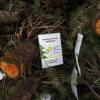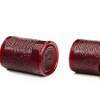I have never witnessed a Christmas tree fire. I have never spoken to anyone who has witnessed a Christmas tree fire.
In my youth, I was warned of the dangers of live trees and the fires they could precipitate, but for the past few Christmastides, I have wondered if they are actually a fire hazard — and I’m not convinced they are.
Soon. pic.twitter.com/KgEFfROIKD
— US Consumer Product Safety Commission (@USCPSC) November 14, 2021
In the early morning hours of Dec. 7, just outside the Fox News headquarters in New York City, a 50-foot artificial tree went up in flames. Mere steps away at Rockefeller Plaza, a 79-foot Norway spruce from Elkton, Maryland, was spared any unexpected combustion. To be fair, this observation is far from a perfect comparison — primarily because the Fox News tree was an alleged act of arson.
The National Fire Protection Association, a nonprofit based in Quincy, Massachusetts, collects data on winter holiday fires. The organization states that between 2015 and 2019, U.S. fire departments responded to an annual average of 160 home fires that started with Christmas trees. An NFPA spokeswoman said a solid fifth of those fires were arson. So that’s just 128 accidental fires, across the entire country, that warranted a fire department response.
During that same period, fire departments responded to an average 7,400 fires started by candles each year, the NFPA reports.
The yearly yuletidewarnings of the combustible Christmas tree might dampen our enthusiasm for the real thing. In 2020, the American Christmas Tree Association estimated that of the 94 million trees in American homes,just 15% of them were real. When asked if more people should buy a real tree, James Horst, executive drector of the New Hampshire-Vermont Christmas Tree Association, said, “would you give your wife plastic flowers for your anniversary?“
While artificial trees are attractive to some for their supposed environmental advantage, much like their plastic boughs, looks can be deceiving. Freelance science writer Kelsey Kennedy grew up on a Christmas tree farm in Sheridan, Oregon. Combined with North Carolina, those two states account for 79% of real Christmas tree production in the U.S. As far as the environmental cost of an artificial tree was concerned, she said there’s a lot to consider. There’s “the fossil fuel use [from] the actual production of the trees,” she said. “The shipping of the tree, it's probably from China. And then you get into the potential health impact of a plastic tree off-gassing in your house.”
Writing for Popular Science, Erin Blakemore reported that “impacts of one year of an artificial tree with a single live Christmas tree” amounted to 8kg of carbon dioxide for the artificials, and 3.1kg of carbon for the real trees — meaning that a live tree isn’t inherently better for the environment than an artificial one. Traveling a long distance to pick up the tree offsets many environmental savings, as does improperly disposing of it after the holidays are over. (The most environmentally friendly modes of tree disposal are to turn it into mulch, return it to nature, or todonate it as goat food.)
Maybe the prevailing myth about Christmas trees as a fire hazard has to do not with the trees' composition, but how we once decorated them.
For starters, lit candles on real trees were par for the course for quite some time — and this is still the case in some Christmas-celebrating parts of the world.
Tree lights weren’t invented until the early 1880s, but it took a while for them to become affordable and widely available. Consider the 1924 Babbs Switch fire, in which a Christmas tree fire broke out in a school house after candles on a live tree ignited wrapping paper, before spreading to dry needles and eventually the whole building.
While modern-day lights can be hazardous, checking for loose bulbs and fraying wires goes a long way in making sure a tree and its environs — stays safe.
However, there isn’t much of a reason to avoid a live tree because of the fire risk it poses, unless you’re already prone to behaving recklessly with sources of heat and are acutely self-aware of that fact.
"The only excuse for having an artificial tree, in Oregon, was if you had an allergy," said Kennedy. Later, she followed up via text: “[I’m] not sure how I’d feel about having a plastic tree sprayed with fire retardant in my house.”
And if you’re committed to keeping your holiday purchases local, then shipping in an artificial tree might be out of the question.
“More people become interested in nature and buying local,” said Horst of the New Hampshire-Vermont Christmas Tree Association, “and a fresh, real Christmas tree is part of that."
Seriously, when’s the last time you found a locally manufactured tree? And to that point, it would do you well to remember that most of these artificial trees are manufactured in China, and the Great Supply Chain Shortage is being felt worldwide (read:the price of artificial trees is going way, way up). So if your spirit is cleaved in twain, agonizing over whether to go artificial, just remember: don’t fear the fire.
“I’m not at all concerned about flammable Christmas trees,” said Horst. “If they’re cut fresh, and watered and taken care of, there's little risk of having your tree catch on fire.”







